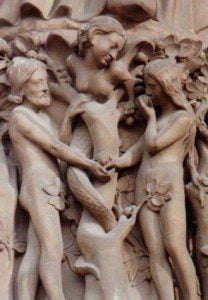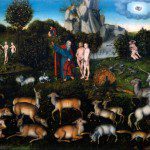 One of the most contentious issues involved in the discussion of the intersection between Christian faith and evolutionary biology is the question of Adam: historical, unique, mythical, archetypal, representative, something else? The recent clarification of the statement of faith at Bryan College is an example of the depth of feeling this issue can evoke. Lines are drawn in the sand.
One of the most contentious issues involved in the discussion of the intersection between Christian faith and evolutionary biology is the question of Adam: historical, unique, mythical, archetypal, representative, something else? The recent clarification of the statement of faith at Bryan College is an example of the depth of feeling this issue can evoke. Lines are drawn in the sand.
According to a story at timesfreepress.com the statement of faith reads:
that the origin of man was by fiat of God in the act of creation as related in the Book of Genesis; that he was created in the image of God; that he sinned and thereby incurred physical and spiritual death
There is no specified method, and this is a statement with which most of us would agree although we might differ on the idea behind “incurred physical death.” The clarification leaves less room for conversation or for agreement.
We believe that all humanity is descended from Adam and Eve. They are historical persons created by God in a special formative act, and not from previously existing life forms.
Many who would without reservation sign the statement of faith cannot in good conscience agree with the clarification. One who, for example, agrees with John Stott in his commentary The Message of Romans: God’s Good News for the World would be fine under the original statement, but now with the “clarification” would be unwelcome on the faculty of Bryan.
For those who are wondering, Stott has a section in his commentary on The historicity and death of Adam (p. 162-166). He finds that “the narrative itself warrants no dogmatism about the six days of creation, since its form and style suggest that it is meant as literary art, not scientific description.” He also finds it likely that the snake and trees are meant to be understood symbolically in Gen 2-3. He holds to the historicity of the original human pair 6000-10,000 years ago largely because of the genealogies (esp. Luke 3) — but not in the sense you might think. He does not deny any of our scientific findings – and will even accede to the possibility (probability) that creation from dust is a Biblical way of saying that God breathed his divine image into an already existing hominoid. But…
The vital truth we cannot surrender is that, though our bodies are related to the primates, we ourselves in our fundamental identity are related to God.(p. 164)
With respect to the intent of Paul in Romans 5: 12 – and so death spread to all men, because all sinned – Stott comments:
There can be only one explanation. All died because all sinned in and through Adam, the representative or federal head of the human race. (p. 152)
Adam’s “federal” headship extended outwards to his contemporaries and onwards to his descendents and this includes, according to Stott, the consequences of Adam’s original sin.
Digging deeper once again. The question of Adam remains one worth posts and discussion. A recent book, Four Views on the Historical Adam (Counterpoints: Bible and Theology), provides us an opportunity to dig into the question of Adam once again. The contributors to the book include Denis Lamoureux, John Walton, C. John Collins, and William Barrick. The views presented range from no historical Adam (Lamoureux) to young earth creation with Adam as the unique father of the entire human race some 6000 years ago or so (Barrick). John Walton and Jack Collins fall between these two views, with Collins likely closest to the view of Stott described above.
In their essays the contributors were asked to respond to three questions:
1. What is the biblical case for your position, and how do you reconcile it with passages and potential interpretations that seem to counter it?
2. In what ways is your view more theologically consistent and coherent than any other view? In particular the contributors were asked to relate their view of Adam to their view of revelation, inerrancy, creation, and redemption in Christ.
3. What are the implications your view has for the spiritual life and public witness of the church and individual believers, and how is your view a healthier alternative for both?
Each contributor provides his own view, responds to the views of the other three, and offers a rejoinder to response of the others to his essay.
The final two chapters provide pastoral reflections by Greg Boyd and Philip Ryken concerning the implications of our view of Adam in the life of the church.
Over the next few months we will look in more detail at the views offered by Lamoureux, Walton, Collins, and Barrick and the objections they raise in response to the views of the others and finally the pastoral responses. If interested, pick up a copy of the book and join in the conversation.
What do you think is the most important aspect of the question of Adam?
Could you sign the original statement of faith at Bryan? If so, would the “clarification” cause problems?
If you wish to contact me directly you may do so at rjs4mail [at] att.net.
If interested you can subscribe to a full text feed of my posts at Musings on Science and Theology.











